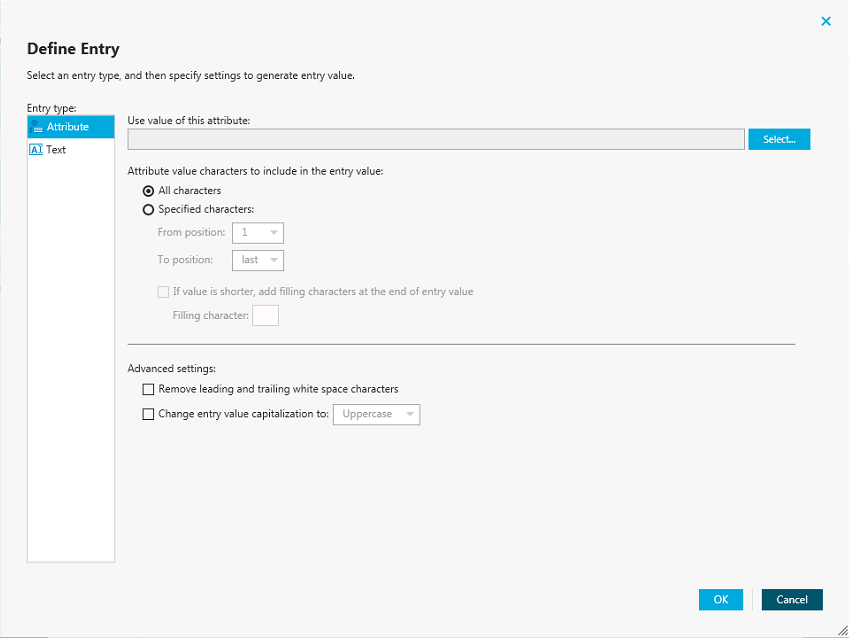To configure a list of rules for selecting an attribute value or generating a value, you can use the Configure Generation Rule dialog.
Figure 19: Configure Generation Rule

To add a new rule entry
-
Click Add.
-
Configure the rule entry as appropriate. For more information, see Configuring a rule entry.
To remove an existing rule entry
To edit an existing rule entry
-
From the Rule entries list, select the entry you want to modify, and then click Edit.
-
Configure the rule entry as appropriate. For more information, see Configuring a rule entry.
This section provides instructions on how to configure a rule entry in the Define Entry dialog that looks similar to the following:
Figure 20: Define Entry

To configure a text entry
-
Under Entry type, select Text.
-
In the Text value box, type the value.
-
Click OK.
To configure an attribute-based entry
-
Under Entry type, select Attribute.
-
Click Select to select the attribute whose value you want to use, and then click OK.
-
If you want the entry to include the entire value of the attribute, select All characters. Otherwise, click Specified characters, then specify the characters to include in the entry.
-
(Optional) To add additional characters to the entry, click If value is shorter, add filling characters at the end of entry value.
-
(Optional) Specify Advanced settings.
-
When finished, click OK.
Sync workflow step handlers allow you to automatically perform custom actions either before running a workflow step or after the workflow step run results have been committed (written) to the data system. Out of the box, includes a single predefined handler type that can automatically run your custom PowerShell script and thus perform the desired action.
To create, modify, or delete handlers for a sync workflow step, you can use the Step Handlers tab in the sync workflow step properties.
To create a sync workflow step handler
- In the Console, open the Sync Workflows tab.
-
Click the name of the appropriate sync workflow.
-
Click the name of the sync workflow step for which you want to create a handler, then click Step Handlers.
-
Click Add handler, then follow the steps in the wizard to create your handler.
To modify a sync workflow step handler
- In the Console, open the Sync Workflows tab.
-
Click the name of the appropriate sync workflow.
-
Click the name of the sync workflow step whose handler you want to modify, then click the Step Handlers tab.
-
Click the name of the handler you want to modify.
-
Modify the handler settings as necessary. When you are finished, click OK.
-
You can also do the following:
-
Change the order in which handlers are activated: activates handlers in the order in which they appear in the list. To move a handler in the list, use the Move up and Move down links below the handler.
-
Disable or enable the handler: You can enable or disable existing handlers. To do so, use the Enable or Disable link below the handler.
-
When you are finished, click Save.
To delete a sync workflow step handler
- In the Console, open the Sync Workflows tab.
-
Click the name of the appropriate sync workflow.
-
Click the name of the sync workflow step whose handler you want to delete, and then click Step Handlers.
-
Click Delete below the handler you want to delete.
This example illustrates how to configure a creating step to synchronize group memberships from an Active Directory domain to an AD LDS (ADAM) instance. The example demonstrates how to create rules in the step to synchronize the value of the member attribute in the AD domain to the member attribute in AD LDS (ADAM).
To synchronize the member attribute
-
Follow the procedure of the Adding a creating step section until you reach the Specify creation rules page.
-
In the Initial Attribute Population Rules element, click the down arrow on the leftmost button below the list to select Forward Sync Rule.
-
In the dialog that opens, add the following pair of attributes:
For more information about the options in this dialog, see Configuring a forward sync rule.
-
When you are finished, click OK.
-
Follow the steps in the wizard to complete the creating step.


